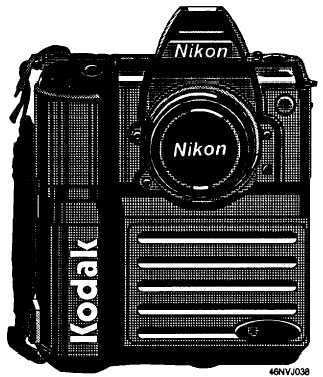The Kodak DCS 200 is a modified Nikon 8008
equipped with a Kodak DCS 200 camera back (fig. 3-6).
The DCS 200 is capable of 1.54 million pixels of
resolution. It also has an internal hard drive that can
store up to 50 images. A small "hitchhiker" 40Mb hard
drive is also available. This 40Mb hard drive plugs
directly into a small computer system interface (SCSI)
port on the camera for additional image storage. The
SCSI is pronounced SCUH-zee.
The advantages of the Kodak DCS 200 over the
Kodak DCS are higher resolution and portability. It is
more portable than the DCS because it has a built-in
hard drive. The disadvantages of the DCS 200 are it
stores less images than the DCS 100, and it has no
built-in compression or transmission capabilities.
One of the biggest advantages of capturing an
image digitally is the way the images can be processed.
A digital image may be re-recorded without loss of
image quality and the color and sharpness can be
enhanced. This digital signal is identical to the signal
used in a computer; thus, by using the proper interface,
the signal from a digital-still camera can be imported
directly into a computer.
FIgure 3-6.—Kodak DCS 200.
Scanners
Film transparencies, negatives, and prints are
sources of images that can be produced and edited
electronically. Scanners can create digitized images
with extremely high resolution. Scanners are also
capable of providing resolution equal to the original
negative or print.
Scanners come in three categories: rotary drum,
flatbed, and film. Rotary-drum scanners provide the
highest quality for converting images from film or
prints, but they are very expensive. Rotary-drum
scanners are capable of producing resolution ranging
from 1,000 to 5,000 dpi. When a rotary-drum scanner
is used, the film or photograph is placed on the surface
of a drum that rotates while the original is scanned by a
single beam of light. The beam of light and the speed
of the drum can be adjusted to control the amount of
resolution desired.
Scanners that use charge-coupled devices (CCDs)
provide excellent quality. They are used in many Navy
imaging facilities. Scanners operate similar to a
photocopy machine. A CCD chip with a row of light
receptors scans a photograph or negative and changes
the colors or shades of gray (analog signal) into digital
values.
Full-color scanners have three rows of CCDs: one
for red, one for green, and one for blue. This tricolor
array permits full-color scanning with a single pass of
the scanning head. The number of elements in the CCD
array determines the resolution of the images being
scanned. For example, an 8.5-inch linear array with
2,540 elements has approximately 300 elements per
inch. This array can produce a digitized image with a
resolution of 300 dots per inch (dpi). Most standard
desktop scanners operate in the 300- to 400-dpi range.
When an image is scanned on a scanner that produces
1,000 to 5,000 dpi, a higher resolution results, but the
scan time and file size also increase. Generally, the
resolution required for a scanned image is limited to the
output of the imaging system.
A flatbed scanner is used for scanning photographs
and artwork. Some flatbed scanners are also capable of
scanning transparencies and color negatives. The
resolution of flatbed scanners range from 200 to 1,200
dpi. Unlike a rotary-drum scanner, a flatbed scanner
scans an entire line at one time with a linear CCD array.
Film scanners are used to scan negatives and
transparencies. Many of these scanners come with
software packages that allow you to crop the image and
3-10



